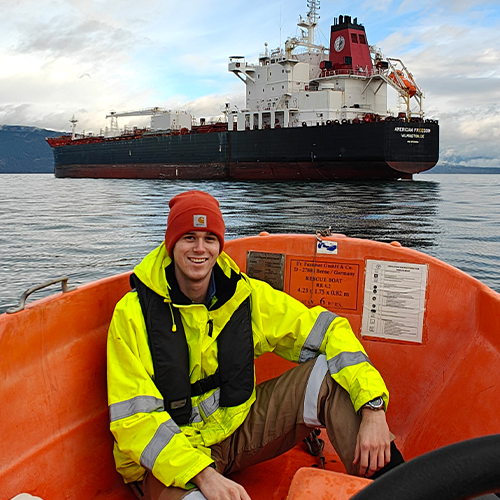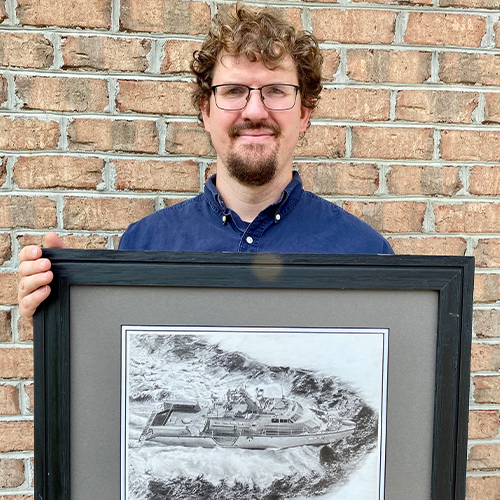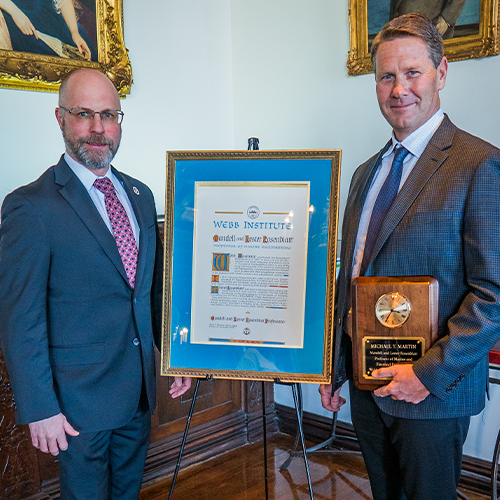Life at Sea: What they don’t tell you about life on an oil tanker
By Spencer Rankin ’27
I wake up with a jolt to see our car stopping at security gates. At about 10 at night, it’s dark and rainy out. An armed guard meets us, asking us for our ID’s and to open our bags. It’s actually happening now, I realize. I’m about to join the oil tanker I’ll be interning on for the next fifty days.
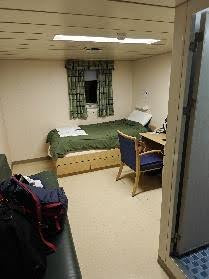
Home sweet home.
I’ve spent the last three hours in a port agent’s car driving north of Seattle to a BP refinery and port. Sitting across from me is the ship’s first assistant engineer, my direct supervisor for the next two months. Yikes. Trying my best to make conversation, I immediately stereotype him as someone who must love to hunt because he’s from Maine. Luckily, he does. I decided to leave the conversation at that and end up dozing off.
Finished scanning our IDs, the guard comes back to search our bags. He looks at mine and asks me to remove the jacket that’s folded on top. “I’m not actually allowed to touch your stuff,” he explains. So much for American security.
A new car arrives to drive us down the one-lane pier to the ship. “No phones out here,” the 1st mutters to me. They’re deemed an explosion risk around the transfer of fuel, occurring at 7,000 m3 / hour.
We climb the gangway to the ship and John shows me to my room. Home sweet home. Having just completed a 17-hour travel day, I’m tired enough to fall dead asleep. Yet, I can’t. My room is lightly vibrating, and I’m not exactly sure where in the ship, let alone the world, I am. “What have I gotten myself into?” I wonder. All I know is I’m in for an adventure.
I quickly settle in. I’m an engine cadet, which means I spend my days in the engine room learning by working alongside the ship’s engineers. All of them went to college for four years and spent 360 days working as cadets (like me) to do this. They know their stuff, and it shows. I, on the other hand, am a bit like a pet baboon. Nice to have around, perhaps, but not particularly useful.
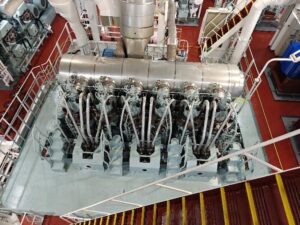
The 3-story tall low-speed diesel engine.
My first day of work I have the unforgettable experience of helping clean excrement off the toilet eductor – the component that makes our toilets flush like on an airplane, used because it’s water efficient. I gladly move on to more enjoyable activities, like servicing pumps and greasing motor gears. It’s humbling to realize just how little I know. Halfway into my stint an MAN technician comes aboard and we open a crankcase inspection door. It’s my first time seeing inside a working low speed diesel engine. These things are huge, three stories tall, and a marvel of engineering. It occurs to me that if not for this opportunity, I would have begun designing ships without really understanding how they work. How can someone possibly design an engine without ever seeing its insides?
Our ship loads refined petroleum in northern Washington, just a few miles south of the border, and brings it down to San Francisco and LA. 600 feet long, we can carry up to 340,000 barrels of oil, which at $2.50 a gallon equates to around $35M of cargo. For that responsibility, the ship’s crew is on charter for $100,000 a day. Most crew are on 75-day rotations – 75 days of work followed by 75 days of vacation. Some have shorter rotations. This is an industry that’s serious about getting the job done.
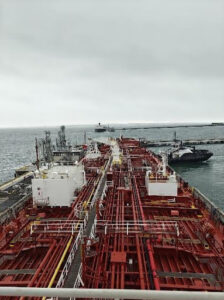
The ship can carry 340,000 barrels of oil at a time.
The days go by at sea, each one mostly like the last. You work, you eat, and you sleep, and that’s about it. About ten days in I lose track of what day of the week it is. It makes no difference, anyways. Having quickly finished the two books I packed and resort to reading the Financial Times. My conversation starters are becoming less interesting by the day.
You can spend months out here without ever interacting with half of the ship’s 20-odd crew. The deck, engine, and steward departments have minimal working interactions, which just leaves mealtimes to socialize amongst each other. When you are eating, the licensed officers and unlicensed crew have different mess halls. You end up learning everyone’s job title – 2nd mate, pumpman, captain, bosun, etc. – but often not their name. It’s weird.
The food is edible. Beyond that, you can’t expect much. Rice and fries have become a staple in my diet, for they are reliably all right. Vegetables are sparsely consumed. I occasionally dream of the day I can visit a café and splurge on a macchiato with a madeleine again. The coffee will be warm and textured with a punch of acidity, and the madeleine sweet with crisp edges and a lemon aroma. Realizing just how outrageous my fantasies are, I decide to keep these thoughts to myself.
I’m definitely not destined for a life out here. It’s exhausting. You are temporarily removed from modern society and all the benefits that come with it. But am I glad I’m doing this? Absolutely. It’s not every day you get the chance to experience working on a 600 foot oil tanker.
Link to my blog: https://medium.com/@spencer.rankin.00
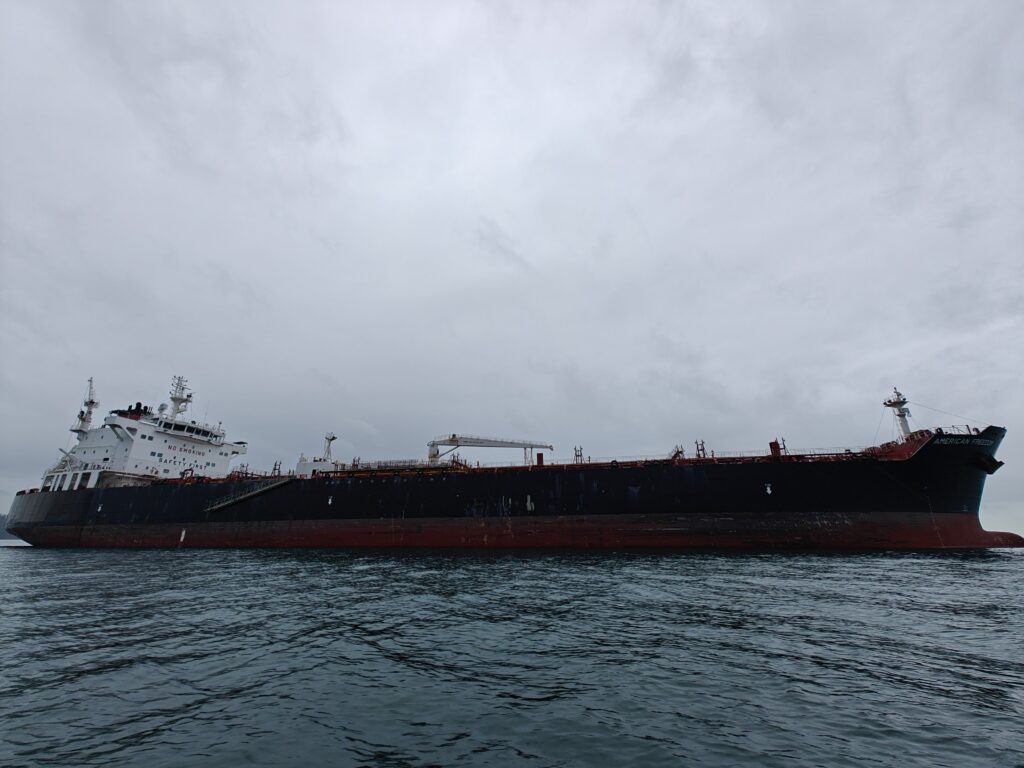
An impressive view of the 600ft oil tanker.
Alumni Spotlight: Ben Fisher ’11 | The Art of Shipbuilding
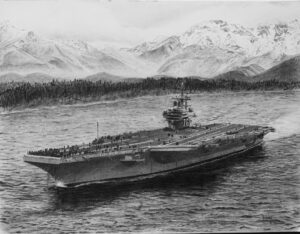 Growing up in rural Pennsylvania, the last thing I expected was to become a naval architect. But after seeing a Titanic documentary when I was four, I knew I was going to do something ship related. That initial encounter with Titanic sparked a love for ships (particularly with dramatic stories), as well as an obsession with drawing. So much so that by the time Middle School came to an end I struggled to identify any appealing career options, since as far as I knew “draw boats” wasn’t a real job.
Growing up in rural Pennsylvania, the last thing I expected was to become a naval architect. But after seeing a Titanic documentary when I was four, I knew I was going to do something ship related. That initial encounter with Titanic sparked a love for ships (particularly with dramatic stories), as well as an obsession with drawing. So much so that by the time Middle School came to an end I struggled to identify any appealing career options, since as far as I knew “draw boats” wasn’t a real job.
But by Divine Appointment the high school art teacher at my small, rural school in the mountains of Pennsylvania knew Professor Gallagher’s family. So, he introduced me to Webb and the career of Naval Architecture.
A great irony of my time at Webb, though, was the slow decline of the time I spent really drawing boats beyond notebook doodles. That trend continued as I began my career at SAFE Boats International (near Seattle) and as my wife and I began raising our family.
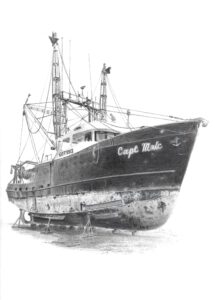
By early 2020, in the midst of COVID, we decided it was time to move back to the east coast in order to be closer to family and away from the dreary Seattle winters. I took a position with Combatant Craft Division, and we began developing our homestead in the country outside of Suffolk, VA with our five children. Through much of that time my drawing paper and pencils languished on the shelf.
It was only in late 2022, when the kids began sleeping better, that the inspiration to start drawing again struck me. I saw an old drawing from high school and wanted to try it again. That experience reignited my love of drawing, and I launched my art studio in June 2023.
As I have started sharing my artwork, one of the surprising results has been the joy I have found in honoring and celebrating the broad maritime history and heritage we love as naval architects, but also the very personal achievements we experience in our careers. The commissions I’ve had the privilege to draw (so far) have celebrated either a career or specific, meaningful project. And it is such an honor to contribute to that celebration through my artwork.
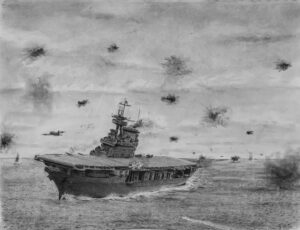 The excitement I’ve found has inspired the idea for a drawing that will celebrate the heritage of American naval architecture broadly. The idea is an image of William Webb’s Young America and William Francis Gibb’s United States crossing paths. The two very patriotically named ships were launched nearly 100 years apart, and both were the product of two incredibly significant naval architects in American maritime history. I am excited about this drawing because of how meaningful I think it will be to people with connections to naval architecture and who take pride in our maritime heritage.
The excitement I’ve found has inspired the idea for a drawing that will celebrate the heritage of American naval architecture broadly. The idea is an image of William Webb’s Young America and William Francis Gibb’s United States crossing paths. The two very patriotically named ships were launched nearly 100 years apart, and both were the product of two incredibly significant naval architects in American maritime history. I am excited about this drawing because of how meaningful I think it will be to people with connections to naval architecture and who take pride in our maritime heritage.
And so, as I am given the privilege of celebrating the achievements of my peers and our shared maritime history and heritage, I am incredibly grateful for the opportunity to make “draw boats” a real job after all.
If you’d like to follow my art journey, you can find my work in my online gallery at BenFisherArt.com.
I also post regularly on social media- I’m on LinkedIn: BenjaminDFisher, Facebook: BenFisherArt and Instagram: Naval_Art.chitect
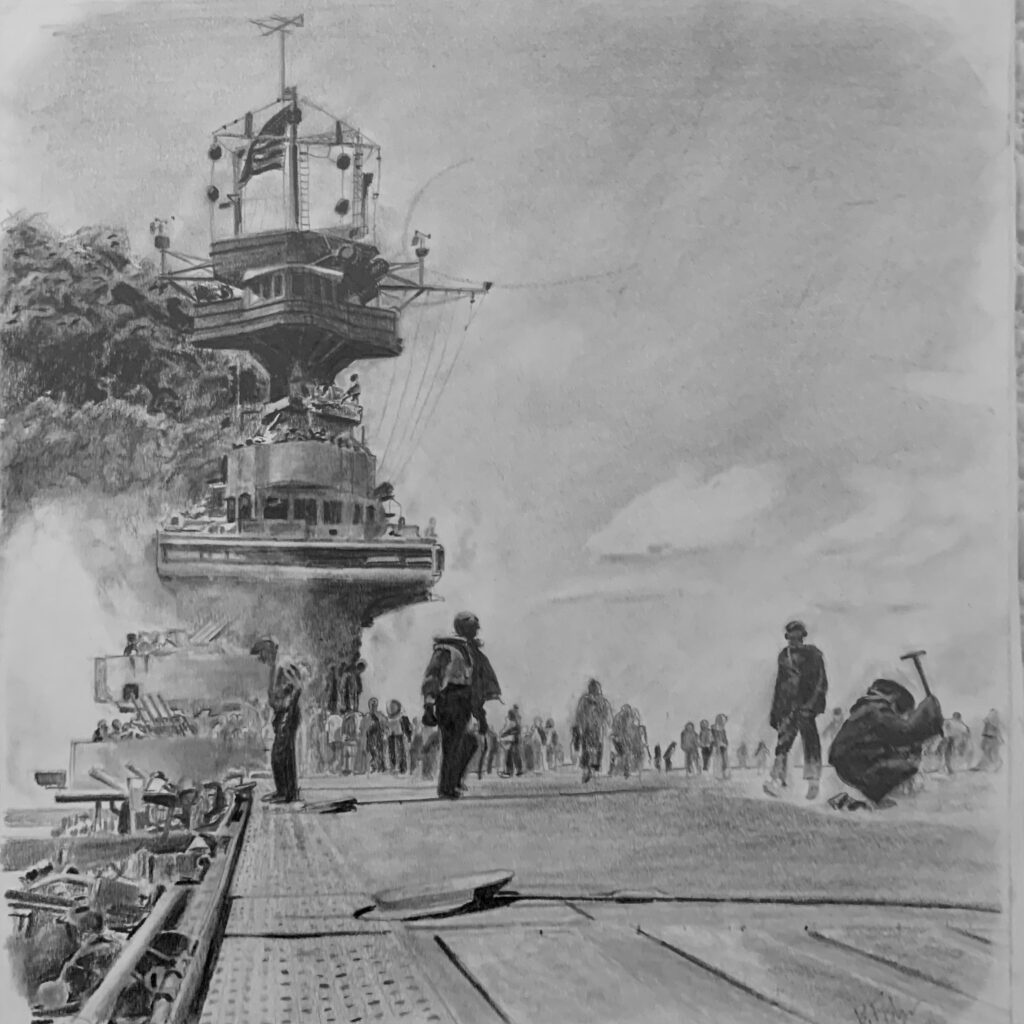
Webb Welcomes Natalie Koetsier as Assistant Director of Admissions
Hailing from Chicago, IL., Natalie Koetsier is an extraverted writer and Michigan native. Graduating from Loyola University Chicago with a BA in English creative writing and minor in advertising, Natalie values effective storytelling, clear communication, innovative thinking, and to never stop learning.
Previously, Natalie has held experiences as a copy editor for an award-winning newspaper and as a resident assistant. Most recently, Natalie worked on a social media team and as a sports writer covering the Detroit Lions, where her articles were the magazine’s top 3 most-viewed articles for the month of November.
Natalie is ecstatic to join Webb’s admissions team and connect prospective Webbies to this exceptional school. She has been around boats her whole life, and some of her favorite family memories are on the family boat in Spring Lake, MI. Natalie is also the proud big sister of Mitchell Koetsier, who is a part of the Webb Institute class of ‘28.
For 10 years, Natalie was a competitive gymnast who won the all-around and the balance beam national title. She still has some gymnastics tricks up her sleeve so do not challenge her to a dance off. For fun, she likes to go on walks, where she can admire water views and/or architecture.
‘Ship as a City’ Project Releases Latest Educational Resources
The ‘Ship as a City’ project, a joint effort between Webb Institute and American Bureau of Shipping (ABS) with support from the National Institute of Standards and Technology (NIST), has now released a suite of educational products designed to enhance maritime education across the board.
This project aimed to create educational material to strengthen the resources available to promote the understanding of documentary standards, standards development, and standardization for personnel entering and currently working in the U.S. maritime industry.
Standards and requirements are critical to every stage of a marine vehicle’s lifecycle from design and construction to operations. These educational materials will provide the long-term benefit of building foundational knowledge of this aspect of the industry, which will serve graduates whether they become marine vehicle operators, designers, port engineers, shipyard managers, or regulators.
The educational materials produced are intended to serve:
- Graduate and Undergraduate-level maritime technical programs (both marine engineering and naval architecture) and capstone projects
- Undergraduate-level maritime license programs (both Deck and Engine Licenses)
- Non-degree technical programs for both licensed and unlicensed mariners
The educational materials produced focus on the following subject areas:
- Standards and the Maritime Industry: What standards are used in marine vehicle design, construction, and operations, and why and how are standards developed in the maritime industry?
- The U.S. Commercial Maritime Industry: Commercial marine vehicle specifications, national and international maritime regulations, and the classification and compliance verification process.
- The U.S. Government Shipbuilding Industry: Government combatant and non-combatant ship and small craft specifications and standards, national and international requirements, and classification variations for Government assets.
- Applying a Standardization Process to Innovation: Applying standards to innovation and new technology.
All materials produced in this project are available to the public free of charge at – https://www.webb.edu/ship-as-a-city-standards-in-the-maritime-industry/.
Editable PowerPoint files will be made available to educators on request.
Questions on this project and the final report should be directed to:
Matthew R. Werner, Webb Institute – ude.bbew@renrewm
Richard Delpizzo, ABS – gro.elgae@ozzipleDR
A Great School Depends on a Great Faculty
By Matthew R. Werner ’95, PG’97
Dean and ABS Chair of Naval Architecture & Marine Engineering
Most of us are aware of the significant effort that Webb expends to select an incoming class of 28 students. Multiple interviews, on-campus assessments, class attendance, and overnight visits build upon the standard college applications, test scores, transcripts, essays, and letters of recommendation. Webb’s substantial investment in time and resources in this endeavor reflects the importance of finding students that can positively contribute to our small, tightknit community, while succeeding academically, and growing personally and professionally.
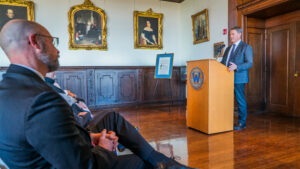
If one out of 28 and one out of 100 is important to the Webb experience, what can we say of one out of 10? Given the small size of Webb’s faculty, the importance of each individual professor in the pursuit of Webb’s mission is significant, much like it is with the carefully selected Webb students. Faculty members serve as the motivating force behind the development of Webb students, through teaching, advising, mentoring, and modeling. Webb’s demanding, high-contact academic program is a challenge for faculty members and students alike, much is demanded from both sides of the lecture podium and laboratory benches. The job of a faculty member at Webb is very demanding and very rewarding at the same time.
Beyond the course syllabi, Webb faculty members help students secure internships and post-graduation jobs through connecting students with their industry networks. Professors’ personal recommendations help students secure competitive scholarships and spots in prestigious graduate schools. Faculty members serve as a resource as students develop their plans for their future beyond Webb. Many faculty members continue to provide support and mentoring to recent graduates as they start their careers.
We often say at Webb that students have nowhere to hide, well the same can be said of faculty members. Webb faculty members’ availability to their students is unprecedented. Posted office hours are not a thing at Webb because if a faculty office is occupied, the door is open to students seeking guidance or support. Daily, I witness students engaging professors beyond the faculty offices, in the lecture rooms after a class ends, in the common spaces of the Couch Academic Center and Stevenson Taylor Hall, and even in the lunch line. Not to mention regularly responding to student emails that arrive in one’s inbox at all manner of times throughout the day and night, weekends and holidays included.
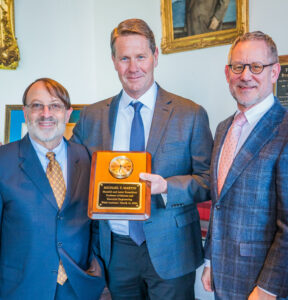
Bruce Rosenblatt, Chair of the Board (left), and Mark Martecchini, President of Webb Institute (right), celebrate Professor Michael Martin as the third Mandell and Lester Rosenblatt Professor of Marine and Electrical Engineering.
In addition to their direct student-facing activities, Webb faculty members manage the operation of the academic enterprise by serving as laboratory and shop directors, and as members of faculty and shared governance committees. Webb’s professors lead Webb’s accreditation activities, conduct research, serve on committees of the board of trustees, and interact with industry while continuing to develop professionally as educators and within their areas of expertise. They create and revise course materials and assignments while continually refining, modifying, and revising courses and the overall curriculum.
Ultimately, a faculty member’s success at Webb comes down to passion. A passion for Webb Institute and its mission. A passion for a culture of high standards and high expectations. A passion for the value of education. A passion for honor, integrity, and personal responsibility. A passion for student development and success. I am thankful everyday that I get to work with a team with the passion and energy that maintains Webb’s place as a model of excellence in engineering education. It is clear to me that a great school depends on a great faculty.

